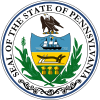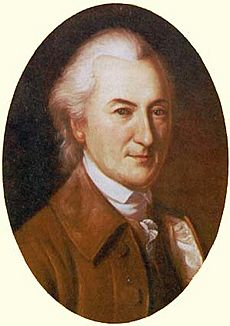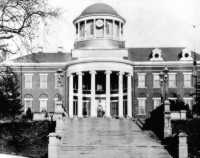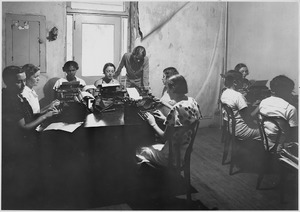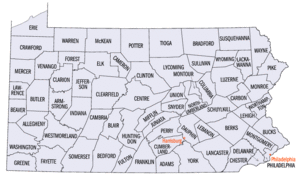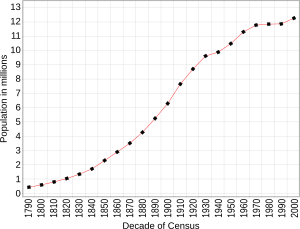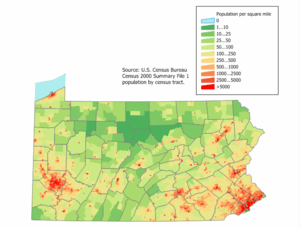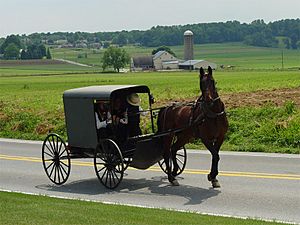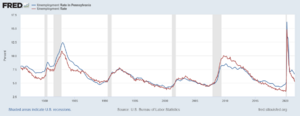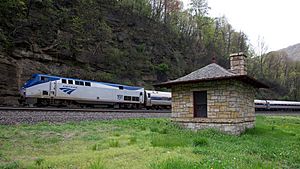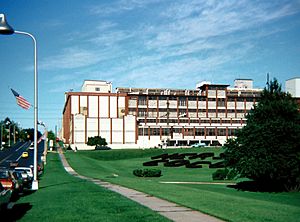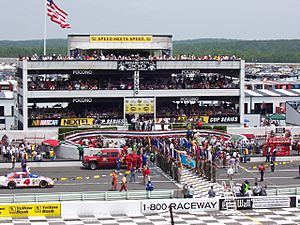Pennsylvania facts for kids
Quick facts for kids
Pennsylvania
Pennsilfaani (Pennsylvania Dutch)
|
|||
|---|---|---|---|
| Commonwealth of Pennsylvania | |||
|
|||
| Nickname(s):
The Keystone State
|
|||
| Motto(s):
Virtue, Liberty and Independence
|
|||
| Anthem: "Pennsylvania" | |||
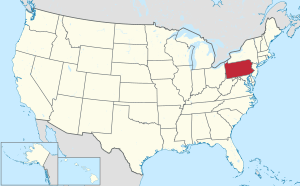
Location of Pennsylvania within the United States
|
|||
| Country | United States | ||
| Before statehood | Province of Pennsylvania | ||
| Admitted to the Union | December 12, 1787 (2nd) | ||
| Capital | Harrisburg | ||
| Largest city | Philadelphia | ||
| Largest county or equivalent | Philadelphia | ||
| Largest metro and urban areas | Delaware Valley | ||
| Legislature | General Assembly | ||
| • Upper house | State Senate | ||
| • Lower house | House of Representatives | ||
| Judiciary | Supreme Court of Pennsylvania | ||
| U.S. senators | John Fetterman (D) Dave McCormick (R) |
||
| U.S. House delegation | 10 Republicans 7 Democrats (list) |
||
| Area | |||
| • Total | 46,055 sq mi (119,283 km2) | ||
| • Land | 44,816.61 sq mi (116,074 km2) | ||
| • Water | 1,239 sq mi (3,208 km2) 2.7% | ||
| Area rank | 33rd | ||
| Dimensions | |||
| • Length | 170 mi (273 km) | ||
| • Width | 283 mi (455 km) | ||
| Elevation | 1,100 ft (340 m) | ||
| Highest elevation | 3,213 ft (979 m) | ||
| Lowest elevation
(Delaware River at Delaware border)
|
0 ft (0 m) | ||
| Population
(2024)
|
|||
| • Total | |||
| • Rank | 5th | ||
| • Density | 291.8/sq mi (112.7/km2) | ||
| • Density rank | 9th | ||
| • Median household income | $73,800 (2023) | ||
| • Income rank | 21st | ||
| Demonym(s) | Pennsylvanian Pennamite Pennsylvanier (Pennsylvania Dutch) |
||
| Language | |||
| • Official language | None | ||
| • Spoken language | |||
| Time zone | UTC– 05:00 (Eastern) | ||
| • Summer (DST) | UTC– 04:00 (EDT) | ||
| USPS abbreviation |
PA
|
||
| ISO 3166 code | US-PA | ||
| Traditional abbreviation | Pa., Penn., Penna. | ||
| Latitude | 39°43′ to 42°16′ N | ||
| Longitude | 74°41′ to 80°31′ W | ||
| Dance | None |
|---|---|
| Bird | Ruffed grouse |
| Fish | Brook trout |
| Flower | Mountain laurel |
| Tree | Eastern hemlock |
| Insect | Firefly (Colloquially "Lightning Bug") (Photuris pensylvanica) |
Pennsylvania ( pen-SIL-vay-NEE-ə, lit. Penn's forest country), officially the Commonwealth of Pennsylvania (Pennsylvania Dutch: Pennsilfaani), is a U.S. state spanning the Mid-Atlantic, Northeastern, Appalachian, and Great Lakes regions of the United States. It borders Delaware to its southeast, Maryland to its south, West Virginia to its southwest, Ohio and the Ohio River to its west, Lake Erie and New York to its north, the Delaware River and New Jersey to its east, and the Canadian province of Ontario to its northwest via Lake Erie.
Pennsylvania was founded in 1681 through a royal land grant to William Penn, the son of the state's namesake. Before that, between 1638 and 1655, a southeast portion of the state was part of New Sweden, a Swedish colony. Established as a haven for religious and political tolerance, the colonial-era Province of Pennsylvania was known for its relatively peaceful relations with native tribes, innovative government system, and religious pluralism.
Pennsylvania played a vital and historic role in the American Revolution and the ultimately successful quest for independence from the British Empire, hosting the First and Second Continental Congress in Philadelphia that formed the Continental Army and appointed George Washington as its commander in 1775, and unanimously adopted the Declaration of Independence the following year. On December 12, 1787, Pennsylvania was the second state to ratify the U.S. Constitution.
In July 1863, the Battle of Gettysburg, fought over three days in and around Gettysburg, was the bloodiest and most decisive battle of the American Civil War, claiming over 50,000 Union and Confederate fatalities and repelling Robert E. Lee's invasion of the North, leading to the Union's preservation. Throughout the late 19th and 20th centuries, the state's manufacturing-based economy contributed to the development of much of the nation's early infrastructure, including key bridges, skyscrapers, and military hardware used in U.S.-led victories in World War I, World War II, and the Cold War.
Pennsylvania's geography is highly diverse. The Appalachian Mountains run through the center of the state, the Allegheny and Pocono mountains span much of Northeastern Pennsylvania, and close to 60% of the state is forested. Although it has no ocean shoreline, it has 140 miles (225 km) of waterfront along Lake Erie and the tidal Delaware River.
Pennsylvania is the fifth-most populous state in the United States, with over 13 million residents as of the 2020 United States census, its highest decennial census count ever. The state is the 33rd-largest by area and has the ninth-highest population density among all states. The largest metropolitan statistical area is the southeastern Delaware Valley, including and surrounding Philadelphia, the state's largest and nation's sixth-most populous city. The second-largest metropolitan area, Greater Pittsburgh, is centered in and around Pittsburgh, the state's second-largest city. The state's subsequent five most populous cities are Allentown, Reading, Erie, Scranton, and Bethlehem.
Contents
History
Long before the Commonwealth was visited and later settled by Europeans, the area was home to subgroups of the Delaware (also known as Lenni Lenape), Susquehannock, Iroquois, Eriez, Shawnee, and still other American Indian Nations of uncertain designation. The Tuscarora Nation took up temporary residence in the central portion of Pennsylvania ca. 1715–55.
17th century
Both the Dutch and the English claimed both sides of the Delaware River as part of their colonial lands in America. The Dutch were the first to take possession.
By June 3, 1631, the Dutch had begun settling the Delmarva Peninsula by establishing the Zwaanendael Colony on the site of present-day Lewes, Delaware. In 1638, Sweden established the New Sweden Colony, in the region of Fort Christina, on the site of present-day Wilmington, Delaware. New Sweden claimed and, for the most part, controlled the lower Delaware River region (parts of present-day Delaware, New Jersey, and Pennsylvania) but settled few colonists there.

On March 12, 1664, King Charles II of England gave James, Duke of York a grant that incorporated all lands included in the original Virginia Company of Plymouth Grant plus other lands. This grant was in conflict with the Dutch claim for New Netherland, which included parts of today's Pennsylvania.
On June 24, 1664, The Duke of York sold the portion of his large grant that included present-day New Jersey to John Berkeley and George Carteret for a proprietary colony. The land was not yet in British possession, but the sale boxed in the portion of New Netherland on the West side of the Delaware River. The British conquest of New Netherland began on August 29, 1664, when New Amsterdam was coerced to surrender while facing cannons on British ships in New York Harbor. This conquest continued, and was completed in October 1664, when the British captured Fort Casimir in what today is New Castle, Delaware.
The Peace of Breda between England, France and the Netherlands confirmed the English conquest on July 21, 1667, although there were temporary reversions.
On September 12, 1672, as part of the Third Anglo-Dutch War, the Dutch re-conquered New York Colony/New Amsterdam, the Dutch established three County Courts which went on to become original Counties in present-day Delaware and Pennsylvania. The one that later transferred to Pennsylvania was Upland. This was partially reversed on February 9, 1674, when the Treaty of Westminster ended the Third Anglo-Dutch War, and reverted all political situations to the status quo ante bellum. The British retained the Dutch Counties with their Dutch names. By June 11, 1674, New York reasserted control over the outlying colonies, including Upland, but the names started to be changed to British names by November 11, 1674. Upland was partitioned on November 12, 1674, producing the general outline of the current border between Pennsylvania and Delaware.
On February 28, 1681, Charles II granted a land charter to William Penn to repay a debt of £16,000 (around £2,100,000 in 2008, adjusting for retail inflation) owed to William's father, Admiral William Penn. This was one of the largest land grants to an individual in history. The King named it Pennsylvania (literally "Penn's Woods") in honor of the Admiral. Penn, the son, who wanted it to be called New Wales, and then Sylvania (from the Latin silva: "forest, woods"), was embarrassed at the change, fearing that people would think he had named it after himself, but King Charles would not rename the grant. Penn established a government with two innovations that were much copied in the New World: the county commission and freedom of religious conviction.
What had been Upland on what became the Pennsylvania side of the Pennsylvania-Delaware Border was renamed as Chester County when Pennsylvania instituted their colonial governments on March 4, 1681. The Quaker leader William Penn had signed a peace treaty with Tammany, leader of the Delaware tribe, beginning a long period of friendly relations between the Quakers and the Indians. Additional treaties between Quakers and other tribes followed. The treaty of William Penn was never violated.
18th century
Between 1730 and when it was shut down by Parliament with the Currency Act of 1764, the Pennsylvania Colony made its own paper money to account for the shortage of actual gold and silver. The paper money was called Colonial Scrip. The Colony issued "bills of credit", which were as good as gold or silver coins because of their legal tender status. Since they were issued by the government and not a banking institution, it was interest-free. It also promoted general employment and prosperity. Benjamin Franklin had a hand in creating this currency.
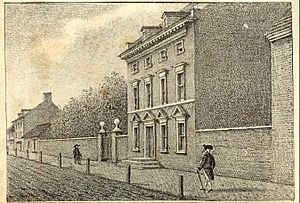
When the Founding Fathers of the United States convened in Philadelphia in 1774, 12 colonies sent representatives to the First Continental Congress. The Second Continental Congress, which also met in Philadelphia (in May 1775), drew up and signed the Declaration of Independence in Philadelphia, but when that city was captured by the British, the Continental Congress escaped westward, meeting at the Lancaster courthouse on Saturday, September 27, 1777, and then to York. There they and its primary author, John Dickinson, drew up the Articles of Confederation that formed 13 independent colonies into a new nation. Later, the Constitution was written, and Philadelphia was once again chosen to be cradle to the new American Nation. The Constitution was drafted and signed at the Pennsylvania State House, now known as Independence Hall, and the same building where the Declaration of Independence was signed.
Pennsylvania became the second state to ratify the U.S. Constitution on December 12, 1787, five days after Delaware became the first.
In 1799 the General Assembly moved to the Lancaster Courthouse, and finally in 1812 to Harrisburg.
19th century
The General Assembly met in the old Dauphin County Court House until December 1821, when the Federal-style "Hills Capitol" (named for its builder, Stephen Hills, a Lancaster architect) was constructed on a hilltop land grant. The Hills Capitol burned down on February 2, 1897, during a heavy snowstorm, presumably because of a faulty flue.
The General Assembly met at Grace Methodist Church on State Street (still standing) until a new capitol could be built.
Following an architectural selection contest, Chicago architect Henry Ives Cobb was charged with designing and building a replacement building; however, the legislature had little money to allocate to the project, and a roughly finished, somewhat industrial building (the Cobb Capitol) was completed. The General Assembly refused to occupy the building. Political and popular indignation in 1901 prompted a second contest that was restricted to Pennsylvania architects, and Joseph Miller Huston of Philadelphia was chosen to design the present Pennsylvania State Capitol that incorporated Cobb's building into magnificent public work finished and dedicated in 1907.
The new state Capitol drew rave reviews. Its dome was inspired by the domes of St. Peter's Basilica in Rome and the United States Capitol. President Theodore Roosevelt called it "the most beautiful state Capital in the nation" and said, "It's the handsomest building I ever saw" at the dedication. In 1989, The New York Times praised it as "grand, even awesome at moments, but it is also a working building, accessible to citizens ... a building that connects with the reality of daily life".
James Buchanan, of Franklin County, the only bachelor President of the United States, was the only one to be born in Pennsylvania.
The Battle of Gettysburg—the major turning point of the Civil War—took place near Gettysburg. An estimated 350,000 Pennsylvanians served in the Union Army forces including 8,600 African American military volunteers.
Pennsylvania was also the home of the first commercially drilled oil well. In 1859, near Titusville, Pennsylvania, Edwin Drake successfully drilled the well, which led to the first major oil boom in United States history.
20th century
At the beginning of the 20th century Pennsylvania's economy was centered around steel production, logging, coal mining, textile production and other forms of industrial manufacturing.
A surge in immigration to the U.S. during the late 19th and early 20th centuries provided a steady flow of cheap labor for these industries which often employed children and people who could not speak English.
Geography
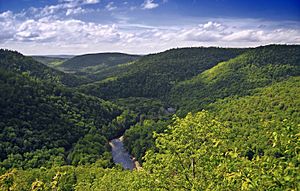
Pennsylvania is 170 miles (274 km) north to south and 283 miles (455 km) east to west. Of a total 46,055 square miles (119,282 km2), 44,817 square miles (116,075 km2) are land, 490 square miles (1,269 km2) are inland waters, and 749 square miles (1,940 km2) are waters in Lake Erie. It is the 33rd largest state in the United States. Pennsylvania has 51 miles (82 km) of coastline along Lake Erie and 57 miles (92 km) of shoreline along the Delaware Estuary.
The boundaries of the state are the Mason–Dixon line (39° 43' N) to the south, the Twelve-Mile Circle on the Pennsylvania-Delaware border, the Delaware River to the east, 80° 31' W to the west and the 42° N to the north, with the exception of a short segment on the western end, where a triangle extends north to Lake Erie.
Cities include Philadelphia, Reading, Lebanon and Lancaster in the southeast, Pittsburgh in the southwest, the tri-cities of Allentown, Bethlehem, and Easton in the central east (known as the Lehigh Valley). The northeast includes the former anthracite coal mining communities of Scranton, Wilkes-Barre, Pittston City (Greater Pittston), and Hazleton. Erie is located in the northwest. Williamsport serves as the commonwealth's north-central region, with York and the state capital Harrisburg on the Susquehanna River in the east-central region of the Commonwealth and Altoona and Johnstown in the west-central region.
The state has 5 regions, namely the Allegheny Plateau, Ridge and Valley, Atlantic Coastal Plain, Piedmont, and the Erie Plain.
Adjacent States
- New York (North)
- Ontario, Canada (Northwest)
- Maryland (South)
- Delaware (Southeast)
- West Virginia (Southwest)
- New Jersey (East)
- Ohio (West)
Governance
Pennsylvania has had five constitutions during its statehood: 1776, 1790, 1838, 1874, and 1968. Before that the province of Pennsylvania was governed for a century by a Frame of Government, of which there were four versions: 1682, 1683, 1696, and 1701. The capital of Pennsylvania is Harrisburg. The legislature meets there in the State Capitol.
In a 2020 study, Pennsylvania was ranked as the 19th hardest state for citizens to vote.
Executive
The executive branch is composed of a Governor, a Lieutenant Governor, an Attorney General, an Auditor General, and Pennsylvania Treasurer. The Governor and Lieutenant Governor run as a ticket in the general election and are up for re-election every four years during the midterm elections. The elections for Attorney General, Auditor General, and Treasurer are held every four years coinciding with a Presidential election.
Legislative
Pennsylvania has a bicameral legislature that was established in the Pennsylvania Constitution, which was ratified in 1790. The original Frame of Government of William Penn had a unicameral legislature. The General Assembly includes 50 senators and 203 representatives.
Judiciary
Pennsylvania is divided into 60 judicial districts. With the exception of Philadelphia County, most have district justices and justices of the peace who preside over most preliminary hearings in felony and misdemeanor offenses, all minor (summary) criminal offenses, and small civil claims. Most criminal and civil cases originate in the Courts of Common Pleas, which also serve as appellate court. The Superior Court hears all appeals from the Courts of Common Pleas not expressly designated to the Commonwealth Court or Supreme Court. All judges in Pennsylvania are elected, and the chief justice of the state's Supreme Court is determined by seniority.
Local government
Pennsylvania is divided into 67 counties. Counties are further subdivided into municipalities that are either incorporated as cities, boroughs, or townships. The most populous county in Pennsylvania and 24th-most populous county in the United States is Philadelphia County, which includes the city of Philadelphia, with a 2020 population of 1,603,797; the state's least populous county is Cameron with a population of 4,547.
There are a total of 56 cities in Pennsylvania, which are classified by population as either first-class, second-class, or third-class cities. Philadelphia, the state's largest city with a population exceeding 1.6 million, is Pennsylvania's only first-class city. Pittsburgh (303,000) and Scranton (76,000) are second-class and second-class 'A' cities, respectively. All of the state's remaining cities including Allentown, the state's third-largest city, and Reading, its fourth-largest, to Parker, the state's smallest city with a population of only 820, are designated as third-class cities. First- and second-class cities are governed by a "strong mayor" form of mayor–council government, whereas third-class cities are governed by either a "weak mayor" form of government or a council–manager government.
Pennsylvania boroughs are generally smaller in population than the state's cities, and most of the state's cities were incorporated as boroughs prior to being designated cities. There are 958 boroughs in Pennsylvania, all of which are governed by the "weak mayor" form of mayor-council government. The largest borough in Pennsylvania is State College (40,501) and the smallest is Centralia.
Townships are the third type of municipality in Pennsylvania and are classified as either first-class or second-class townships. There are 1,454 second-class townships and 93 first-class townships. Second-class townships can become first-class townships if they have a population density greater than 300 inhabitants per square mile (120/km2) and a referendum is passed supporting the change. Pennsylvania's largest township is Upper Darby Township (85,681), and the smallest is East Keating Township.
There is one exception to the types of municipalities in Pennsylvania: Bloomsburg was incorporated as a town in 1870 and is, officially, the only town in the state. In 1975, McCandless Township adopted a home-rule charter under the name of "Town of McCandless", but is, legally, still a first-class township. The state has 56 cities, 958 boroughs, 93 first-class townships, 1,454 second-class townships, and one town (Bloomsburg) for a total of 2,562 municipalities.
Demographics
| Historical population | |||
|---|---|---|---|
| Census | Pop. | %± | |
| 1790 | 434,373 | — | |
| 1800 | 602,365 | 38.7% | |
| 1810 | 810,091 | 34.5% | |
| 1820 | 1,049,458 | 29.5% | |
| 1830 | 1,348,233 | 28.5% | |
| 1840 | 1,724,033 | 27.9% | |
| 1850 | 2,311,786 | 34.1% | |
| 1860 | 2,906,215 | 25.7% | |
| 1870 | 3,521,951 | 21.2% | |
| 1880 | 4,282,891 | 21.6% | |
| 1890 | 5,258,113 | 22.8% | |
| 1900 | 6,302,115 | 19.9% | |
| 1910 | 7,665,111 | 21.6% | |
| 1920 | 8,720,017 | 13.8% | |
| 1930 | 9,631,350 | 10.5% | |
| 1940 | 9,900,180 | 2.8% | |
| 1950 | 10,498,012 | 6.0% | |
| 1960 | 11,319,366 | 7.8% | |
| 1970 | 11,793,909 | 4.2% | |
| 1980 | 11,863,895 | 0.6% | |
| 1990 | 11,881,643 | 0.1% | |
| 2000 | 12,281,054 | 3.4% | |
| 2010 | 12,702,379 | 3.4% | |
| 2020 | 13,002,700 | 2.4% | |
| 2023 (est.) | 12,961,683 | 2.0% | |
| Source: 1910–2020 | |||
As of the 2020 U.S. census, Pennsylvania had a population of 13,011,844, up from 12,702,379 in 2010. Pennsylvania is the fifth-most populated state in the U.S. after California, Texas, Florida, and New York. In 2019, net migration to other states resulted in a decrease of 27,718, and immigration from other countries resulted in an increase of 127,007. Net migration to Pennsylvania was 98,289. Migration of native Pennsylvanians resulted in a decrease of 100,000 people. 7.2% of the population was foreign-born as of 2021.
According to the U.S. Department of Housing and Urban Development's 2022 Annual Homeless Assessment Report, there were an estimated 12,691 homeless people in Pennsylvania.
Place of origin
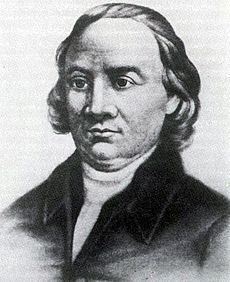
Of the people residing in Pennsylvania, 74.5% were born in Pennsylvania, 18.4% were born in a different U.S. state, 1.5% were born in Puerto Rico, U.S. Island areas, or born abroad to American parent(s), and 5.6% were foreign born. Foreign-born Pennsylvanians are largely from Asia (36.0%), Europe (35.9%), and Latin America (30.6%), with the remainder from Africa (5%), North America (3.1%), and Oceania (0.4%).
The largest ancestry groups are listed below, expressed as a percentage of total people who responded with a particular ancestry for the 2010 census:
Race and ethnicity
| Race and ethnicity | Alone | Total | ||
|---|---|---|---|---|
| White (non-Hispanic) | 73.4% |
|
76.6% |
|
| African American (non-Hispanic) | 10.5% |
|
11.8% |
|
| Hispanic or Latino | — | 8.1% |
|
|
| Asian | 3.9% |
|
4.5% |
|
| Native American | 0.1% |
|
1.1% |
|
| Pacific Islander | 0.02% |
|
0.1% |
|
| Other | 0.4% |
|
1.3% |
|
| Racial composition | 1990 | 2000 | 2010 |
|---|---|---|---|
| White | 88.5% | 85.4% | 81.9% |
| Black | 9.2% | 10.0% | 10.9% |
| Asian | 1.2% | 1.8% | 2.8% |
| Native | 0.1% | 0.1% | 0.2% |
| Native Hawaiian and other Pacific Islander |
– | – | – |
| Other race | 1.0% | 1.5% | 2.4% |
| Two or more races | – | 1.2% | 1.9% |
Pennsylvania's Hispanic or Latino American population grew by 82.6% between 2000 and 2010, making it one of the largest increases in a state's Hispanic population. The significant growth of the Hispanic or Latino population is due to migration to the state mainly from Puerto Rico, which is a U.S. territory, but to a lesser extent immigration from countries such as the Dominican Republic, Mexico, and various Central and South American nations, as well as from the wave of Hispanic and Latinos leaving New York and New Jersey for safer and more affordable living. The Asian population swelled by almost 60%, which was fueled by Indian, Vietnamese, and Chinese immigration, as well the many Asian transplants moving to Philadelphia from New York. The rapid growth of this community has given Pennsylvania one of the largest Asian populations in the nation by numerical values. The Black and African American population grew by 13%, which was the largest increase in that population amongst the state's peers (New York, New Jersey, Ohio, Illinois, and Michigan). Twelve other states saw decreases in their non-Hispanic white populations. The state has a high in-migration of black and Hispanic people from other nearby states, with eastern and south-central portions of the state seeing the bulk of the increases.
The majority of Hispanic or Latino Americans in Pennsylvania are of Puerto Rican descent, having one of the largest and fastest-growing Puerto Rican populations in the country. Most of the remaining Hispanic or Latino population is made up of Mexicans and Dominicans. Most Hispanic or Latinos are concentrated in Philadelphia, Lehigh Valley and South Central Pennsylvania. Pennsylvania's reported population of Hispanics or Latino Americans, especially among the Black race, has markedly increased in recent years. The Hispanic or Latino population is greatest in Bethlehem, Allentown, Reading, Lancaster, York, and around Philadelphia. It is not clear how much of this change reflects a changing population and how much reflects increased willingness to self-identify minority status. As of 2010, it is estimated that about 85% of all Hispanics or Latino Americans in Pennsylvania live within a 150-mile (240 km) radius of Philadelphia, with about 20% living within the city itself.
Of the black population, the vast majority in the state are African American, being descendants of African slaves brought to the U.S. south during the colonial era. There are also a growing number of blacks of West Indian, recent African, and Hispanic or Latino origins. Most blacks live in the Philadelphia area, Pittsburgh, and South Central Pennsylvania. Non-Hispanic whites make up the majority of Pennsylvania; they are mostly descended from German, Irish, Scottish, Welsh, Italian, and English immigrants. Rural portions of South Central Pennsylvania are famous nationwide for their notable Amish communities. The Wyoming Valley, consisting of Scranton and Wilkes-Barre, has the highest percentage of white residents of any metropolitan area (with a population of 500,000 or above) in the U.S., with 96.2% of its population claiming to be white with no Hispanic background.
The center of population of Pennsylvania is located in Perry County, in the borough of Duncannon.
Age and poverty
As of the 2010 census, Pennsylvania had the fourth-highest proportion of elderly (65+) citizens in the nation at 15.4%, compared to a national average of 13.0%. According to U.S. Census Bureau estimates, the state's poverty rate was 12.5% in 2017 compared to 13.4% for the U.S. as a whole.
Languages
| Language | Percentage of population (as of 2010) |
|---|---|
| Spanish | 4.1% |
| German (including Pennsylvania Dutch) | 0.9% |
| Chinese (including Mandarin) | 0.5% |
| Italian | 0.4% |
| French | 0.3% |
| Russian | 0.3% |
| Vietnamese | 0.3% |
| Korean | 0.3% |
| Polish | 0.2% |
| Arabic | 0.2% |
| Hindi | 0.2% |
As of 2010, 90.2% (10,710,239) of Pennsylvania residents age 5 and older spoke English at home as a primary language, while 4.1% (486,058) spoke Spanish, 0.9% (103,502) German (which includes Pennsylvania Dutch) and 0.5% (56,052) Chinese (which includes Mandarin) of the population over the age of five. In total, 9.9% (1,170,628) of Pennsylvania's population age 5 and older spoke a mother language other than English.
Pennsylvania Dutch language
Pennsylvania German is often—even though misleadingly—called "Pennsylvania Dutch". The term Dutch used to mean "German" (including the Netherlands), before the Latin name for them replaced it (but stuck with the Netherlands). When referring to the language spoken by the Pennsylvania Dutch people (Pennsylvania German) it means "German" or "Teutonic" rather than "Netherlander". Germans, in their own language, call themselves "Deutsch", (Pennsylvania German: "Deitsch"). The Pennsylvania German language is a descendant of German, in the West Central German dialect family. It is closest to Palatine German. Pennsylvania German is still very vigorous as a first language among Old Order Amish and Old Order Mennonites (principally in the Lancaster County area), whereas it is almost extinct as an everyday language outside the plain communities, though a few words have passed into English usage.
Religion
| Religion in Pennsylvania (2014) | ||||
|---|---|---|---|---|
| religion | percent | |||
| Protestant | 47% | |||
| Catholic | 24% | |||
| Unaffiliated | 21% | |||
| Other faiths/don't know | 2% | |||
| Hindu | 1% | |||
| Jehovah's witnesses | 1% | |||
| Jewish | 0.8% | |||
| Muslim | 0.6% | |||
Of all the colonies, only Rhode Island had religious freedom as secure as in Pennsylvania. Voltaire, writing of William Penn in 1733, observed: "The new sovereign also enacted several wise and wholesome laws for his colony, which have remained invariably the same to this day. The chief is, to ill-treat no person on account of religion, and to consider as brethren all those who believe in one God." One result of this uncommon freedom was a wide religious diversity, which continues to the present.
Pennsylvania's population in 2010 was 12,702,379; of these, 6,838,440 (53.8%) were estimated to belong to some sort of organized religion. According to the Association of Religion Data Archives (ARDA) at Pennsylvania State University, the largest religious bodies in Pennsylvania by adherents were the Roman Catholic Church with 3,503,028 adherents, the United Methodist Church with 591,734 members, and the Evangelical Lutheran Church in America with 501,974 members. Since 2014 among the religious population, 73% of the state was Christian per the Pew Research Center. In 2020, the Public Religion Research Institute estimated 68% of the population identified with Christianity. Among all surveys, the Roman Catholic Church remained the single-largest Christian denomination in the state.
Pennsylvania, especially in the west and in the Pittsburgh area, has one of the largest communities of Presbyterians in the nation, being the third highest by percentage of population and the largest outright in membership as Protestant Christians. The Presbyterian Church (USA), with about 250,000 members and 1,011 congregations, is the largest Presbyterian denomination while the Presbyterian Church in America is also significant, with 112 congregations and approximately 23,000 adherents; the EPC has around 50 congregations, as well as the ECO according to 2010 estimates. The fourth-largest Protestant denomination, the United Church of Christ, has 180,000 members and 627 congregations in the state. The American Baptist Churches USA (also referred to as the Northern Baptist Convention) is based in King of Prussia, Pennsylvania.
Pennsylvania was the center state of the German Reformed denomination from the 1700s. Bethlehem, Pennsylvania, is one of the headquarters of the Moravian Church in America. Pennsylvania also has a very large Amish population, second only to Ohio among U.S. states. In the year 2000 there was a total Amish population of 47,860 in Pennsylvania and a further 146,416 Mennonites and 91,200 Brethren. The total Anabapist population including Bruderhof was 232,631, about two percent of the population. While Pennsylvania owes its existence to Quakers, and much of the historic character of the Commonwealth is ideologically rooted in the teachings of the Religious Society of Friends (as they are officially known), practicing Quakers are a small minority of about 10,000 adherents in 2010.
Economy
As of 2023, Pennsylvania's gross state product (GSP) of $974,558 billion is the sixth-largest among all U.S. states behind California, Texas, New York, Florida, and Illinois. If Pennsylvania were an independent country, its economy, as of 2023, would rank as the 20th-largest in the world. On a per capita basis, Pennsylvania's 2021 per capita income of $68,957 ranks 21st among the 50 states. As of 2016, there were 5,354,964 people in employment in Pennsylvania with 301,484 total employer establishments. As of January 2024, the state's unemployment rate is 3.4%.
The state has five manufacturing centers: Philadelphia in the southeast, Pittsburgh in the southwest, Erie in the northwest, Scranton-Wilkes-Barre in the northeast, and the Lehigh Valley in the east.
Pennsylvania is home to 23 of the nation's 500 largest companies that comprise the Fortune 500, including two that rank in the top 100, Cencora (formerly AmeriSource Bergen) in Conshocken, which is the nation's 11th-largest company, and Comcast in Philadelphia, which is the 29th-largest. Philadelphia is home to six of the Fortune 500 companies, with more located in suburbs like King of Prussia; it is a leader in the financial and insurance industries. Pittsburgh is home to eight Fortune 500 companies, including U.S. Steel, PPG Industries, Heinz, and GE Transportation. Hershey is home to The Hershey Company, one of the world's largest chocolate manufacturers. In eastern Pennsylvania, the Lehigh Valley has become an epicenter for the growth of the U.S. logistics industry, including warehousing and the intermodal transport of goods.
Like many U.S. states, Walmart is the largest private employer in Pennsylvania. The state's second-largest employer is the University of Pennsylvania, an Ivy League private research university in Philadelphia. Pennsylvania is home to the oldest investor-owned utility company in the U.S., The York Water Company.
As of 2018, Pennsylvania ranks first in the nation in a few economic sectors and niches, including barrels of beer produced annually (3.9 million), farmers' markets (over 6,000), food processing companies (2,300), hardwood lumber production (a billion board feet annually), mushroom farms (68), natural gas production, potato chip manufacturing (24 facilities manufacturing one-fourth of the nation's total), and pretzel manufacturing (80 percent of the nation's total).
Agriculture
Pennsylvania ranks 19th overall among all states in agricultural production. Its leading agricultural products are mushrooms, apples, Christmas trees, layer chickens, nursery, sod, milk, corn for silage, grapes (including juice grapes), and horses production. Pennsylvania ranks eighth in the nation in winemaking.
The Pennsylvania Department of Agriculture worked with private companies to establish "PA Preferred" as a way to brand agricultural products grown or made in the state. The financial impact of agriculture in Pennsylvania includes employment of more than 66,800 people employed by the food manufacturing industry and over $1.7 billion in food product export as of 2011.
Banking
The first nationally chartered bank in the U.S., the Bank of North America, was founded in 1781 in Philadelphia. After a series of mergers, the Bank of North America is now part of Wells Fargo. Pennsylvania is home to the first nationally-chartered bank under the 1863 National Banking Act. That year, the Pittsburgh Savings & Trust Company received a national charter and renamed itself the First National Bank of Pittsburgh as part of the National Banking Act. That bank is still in existence today as PNC and remains based in Pittsburgh. PNC is currently the state's largest and the nation's sixth-largest bank.
Film
The Pennsylvania Film Production Tax Credit began in 2004 and stimulated the development of a film industry in the state.
Gambling
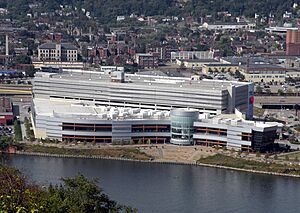
Casino gambling was legalized in Pennsylvania in 2004. As of 2022, there are 16 casinos in the state.
Education
Pennsylvania has 500 public school districts, thousands of private schools, publicly funded colleges and universities, and over 100 private institutions of higher education.
Primary and secondary education
Under state law, school attendance in Pennsylvania is mandatory for children between ages eight and 17, or until graduation from an accredited high school, whichever is earlier, unless students are homeschooled. As of 2005, 83.8% of Pennsylvania residents age 18 to 24 are high school graduates; Among residents age 25 and over, 86.7% have graduated from high school.
The following are the four-year graduation rates for students completing high school in 2016:
| Cohort | All Students | Male | Female | White | Hispanic | Black | Asian | Special Education |
|---|---|---|---|---|---|---|---|---|
| % graduating | 86.09 | 84.14 | 88.13 | 90.48 | 72.83 | 73.22 | 91.21 | 74.06 |
Among Pennsylvania high school graduates as of 2009, 27.5% of them went on to obtain a bachelor's degree or higher degree. State students consistently do well in standardized testing. In 2007, Pennsylvania ranked 14th in the nation in mathematics, 12th in reading, and 10th in writing for eighth grade students. In 1988, the Pennsylvania General Assembly passed Act 169, which allows parents or guardians to homeschool their children as an alternative to compulsory school attendance. The law specifies varying geographic requirements and responsibilities on the part of parents and school districts.
Higher education

The Pennsylvania State System of Higher Education (PASSHE), which includes 14 state-owned universities and colleges, is Pennsylvania's public university system. West Chester University is by far the largest of the 14 with nearly 15,000 students. The Commonwealth System of Higher Education is the organizing body of Pennsylvania's four state-related schools, which include Pennsylvania State University, Lincoln University, the University of Pittsburgh, and Temple University. There are 15 publicly funded two-year community colleges and technical schools in Pennsylvania that are separate from the PASSHE system, and many private two- and four-year technical schools, colleges, and universities.
Carnegie Mellon University, Pennsylvania State University, the University of Pennsylvania, and the University of Pittsburgh are members of the Association of American Universities, an invitation-only organization of leading research universities. Lehigh University is a private research university located in Bethlehem. The Pennsylvania State University is Pennsylvania's land-grant university, Sea Grant College and, Space Grant College. The University of Pennsylvania, located in Philadelphia, is considered the first university in the United States and established the country's first medical school.
The University of Pennsylvania, founded in Philadelphia in 1740 by Benjamin Franklin, is Pennsylvania's only Ivy League university, and is the geographically most southern of the nation's eight Ivy League universities. The Lake Erie College of Osteopathic Medicine (LECOM) is a private graduate school of medicine, dentistry, and pharmacy with a main campus in Erie, a branch campus located in Greensburg, and two additional campuses outside Pennsylvania. With over 2,200 enrolled medical students, the Lake Erie College of Osteopathic Medicine is the largest medical school in the United States. The Pennsylvania Academy of the Fine Arts is the first and oldest art school in the United States. Philadelphia College of Pharmacy, now a part of University of the Sciences in Philadelphia, was the first pharmacy school in the United States.
Recreation

Pennsylvania is home to the nation's first zoo, the Philadelphia Zoo. Other long-accredited AZA zoos include the Erie Zoo and the Pittsburgh Zoo & PPG Aquarium. The Lehigh Valley Zoo and ZooAmerica are other notable zoos.
Pennsylvania is home to some of the most notable museums in the nation, including the Allentown Art Museum in Allentown, Carnegie Museums in Pittsburgh, the Philadelphia Museum of Art in Philadelphia, and several others. One unique museum is the Houdini Museum in Scranton, the only building in the world devoted to the legendary magician. Pennsylvania is also home to the National Aviary, located in Pittsburgh.
All 121 state parks in Pennsylvania feature free admission.
Pennsylvania's notable amusement parks include Conneaut Lake Park, Dorney Park & Wildwater Kingdom, Dutch Wonderland, DelGrosso's Amusement Park, Great Wolf Lodge, Hersheypark, Idlewild Park, Kalahari Resorts Poconos, Kennywood, Knoebels, Lakemont Park, Sandcastle Waterpark, Sesame Place Philadelphia, and Waldameer Park. The largest indoor waterpark resort on the U.S. East Coast is Splash Lagoon in Erie.
The state's notable music festivals include Musikfest, the nation's largest free music festival held annually each August in Bethlehem, the Philadelphia Folk Festival, Creation Festival, and Purple Door. The Great Allentown Fair, held annually at the Allentown Fairgrounds since the 19th century, is one of the nation's longest-running annual fairs.
There are nearly one million licensed hunters in Pennsylvania. White-tail deer, black bear, cottontail rabbit, squirrel, turkey, and grouse are common game species. Pennsylvania is considered one of the finest wild turkey hunting states in the nation, alongside Texas and Alabama. Sport hunting in Pennsylvania provides a massive boost for the state's economy. A report from The Center for Rural Pennsylvania, a legislative agency of the Pennsylvania General Assembly, reported that hunting, fishing, and furtaking generated a total of $9.6 billion statewide.
The Boone and Crockett Club reports that five of the ten largest black bear entries came from the state. The state also has a tied record for the largest hunter shot black bear in the Boone and Crockett record books at 733 lb (332 kg) and a skull of 23 3/16, tied with a bear shot in California in 1993. As of 2007, Pennsylvania has the second highest number of Boone and Crockett-recorded record black bears at 183, behind Wisconsin's 299.
Transportation
The Pennsylvania Department of Transportation, abbreviated as PennDOT, is responsible for transport issues in Pennsylvania.
Air
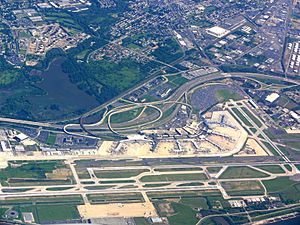
Pennsylvania has seven major airports: Philadelphia International, Pittsburgh International, Lehigh Valley International, Harrisburg International, Wilkes-Barre/Scranton International, Erie International, and University Park Airport. A total of 134 public-use airports are located in the state.
Bus and coach
Intercity bus service is provided between cities in Pennsylvania and other major points in the Northeast by Bolt Bus, Fullington Trailways, Greyhound Lines, Martz Trailways, Megabus, OurBus, Trans-Bridge Lines, and various Chinatown bus companies. In 2018, OurBus began offering service from West Chester, Malvern, King of Prussia, and Fort Washington to New York City.
Highways and roads
PennDOT owns 39,861 miles (64,150 km) of the 121,770 miles (195,970 km) of roadway in the state, making it the fifth-largest state highway system in the United States. The Pennsylvania Turnpike system is 535 miles (861 km) long, with the mainline portion stretching from Ohio to Philadelphia and New Jersey. It is overseen by the Pennsylvania Turnpike Commission. Another major east–west route is Interstate 80, which runs primarily in the northern tier of the state from Ohio to New Jersey at the Delaware Water Gap. Interstate 90 travels the relatively short distance between Ohio and New York through Erie County, in the extreme northwestern part of the state.
Primary north–south highways are Interstate 79 from its terminus in Erie through Pittsburgh to West Virginia, Interstate 81 from New York state through Scranton, Lackawanna County and Harrisburg to Maryland and Interstate 476, which begins 7 miles (11 km) north of the Delaware border, in Chester, Delaware County and travels 132 miles (212 km) to Clarks Summit, where it joins I-81. All but 20 miles (32 km) of I-476 is the Northeast Extension of the Pennsylvania Turnpike. The highway south of the Pennsylvania Turnpike is officially called the "Veterans Memorial Highway", but is commonly referred to colloquially as the "Blue Route".
Rail
SEPTA is the sixth-largest transit agency in the United States and operates the commuter, heavy and light rail transit, and transit bus service in the Philadelphia metropolitan area. Pittsburgh Regional Transit is the 25th-largest transit agency and provides transit bus and light rail service in and around Pittsburgh.
Intercity passenger rail transit is provided by Amtrak, with the majority of traffic occurring on the Keystone Service in the high-speed Keystone Corridor between Harrisburg and Philadelphia's 30th Street Station before heading north to New York City, and the Northeast Regional, which provides regular high-speed service up and down the Northeast Corridor. The Pennsylvanian follows the same route from New York City to Harrisburg, but extends out to Pittsburgh. The Capitol Limited also passes through Pittsburgh, as well as Connellsville, on its way from Chicago to Washington, D.C. Traveling between Chicago and New York City, the Lake Shore Limited passes through Erie once in each direction. There are 67 short-line, freight railroads operating in Pennsylvania, the highest number in any U.S. state. With more than four million inter-city rail passengers in 2018, Philadelphia's 30th Street Station is Amtrak's third-busiest train station in the nation after Penn Station in Manhattan and Union Station in Washington, D.C., and North America's 12th-busiest train station overall.
Water
The Port of Pittsburgh is the second-largest inland port in the United States and the 18th-largest port overall; the Port of Philadelphia is the 24th-largest port in the United States. Pennsylvania's only port on the Great Lakes is located in Erie. The Allegheny River Lock and Dam Two is the most-used lock operated by the United States Army Corps of Engineers of its 255 nationwide. The dam impounds the Allegheny River near Downtown Pittsburgh.
Culture
Food

In 2008, author Sharon Hernes Silverman wrote in the Pittsburgh Tribune-Review that Pennsylvania was the snack food capital of the world. It leads all other states in the manufacture of pretzels and potato chips. In 1861, as the Civil War was beginning, Sturgis Pretzel House in Lititz was first to introduce the pretzel to American consumers. Two other Pennsylvania-based companies, Immergut Hand-Rolled Soft Pretzels in Intercourse and Snyder's of Hanover in Hanover, are leading national pretzel manufacturers. Two of the nation's three leading potato chip companies are based in Pennsylvania: Utz Brands, which started making chips in Hanover in 1921, and Wise Foods, which started making chips in Berwick the same year; the third, Frito-Lay is owned by Plano, Texas-based PepsiCo. Additional Pennsylvania-based companies, including Herr's Snacks in Nottingham, Martin's Potato Chips in Thomasville, are popular chip manufacturers.
The Hershey Company in Hershey is a nearly $9 billion a year company and one of the world's leading manufacturers of chocolate; the company was founded in Hershey by Milton S. Hershey in 1894. Gertrude Hawk Chocolates is headquartered in Dunmore. Other notable companies include Just Born in Bethlehem, makers of Hot Tamales, Mike and Ikes, the Easter favorite marshmallow Peeps, and Boyer Brothers of Altoona, which manufacturers Mallo Cups. The pretzel company Auntie Anne's began as a market-stand in Downingtown, and now has corporate headquarters in Lancaster. Traditional Pennsylvania Dutch foods include chicken potpie, ham potpie, schnitz un knepp (dried apples, ham, and dumplings), fasnachts (raised doughnuts), scrapple, pretzels, bologna, chow-chow, and Shoofly pie. Martin's Famous Pastry Shoppe, headquartered in Chambersburg, Pennsylvania, specializes in potato bread, another traditional Pennsylvania Dutch food. D.G. Yuengling & Son, America's oldest brewery, has been brewing beer in Pottsville since 1829.
Among the regional foods associated with Philadelphia are cheesesteaks, hoagies, soft pretzels, Italian water ice, Irish potato candy, scrapple, Tastykake, and strombolis. In Pittsburgh, tomato ketchup was improved by Henry John Heinz from 1876 to the early 20th century. Famous to a lesser extent than Heinz ketchup is the Pittsburgh's Primanti Brothers Restaurant sandwiches, pierogies, and city chicken. In northeastern Pennsylvania, Italian heritage has popularized a variety of pizza styles. Outside of Scranton, in Old Forge, there are dozens of Italian restaurants specializing in pizza made with thick, light crust, and American cheese. New York–style pizza is popular in Wilkes-Barre. Erie also has its share of foods, including Greek sauce and sponge candy. Sauerkraut along with pork and mashed potatoes is a traditional meal on New Year's Day in Pennsylvania; its tradition began with the Pennsylvania Dutch who believe the meal leads to good luck in the new year to come.
Sports
Professional sports


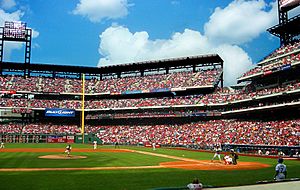
Pennsylvania is home to eight major league professional sports teams: the Philadelphia Phillies and Pittsburgh Pirates of Major League Baseball, the Philadelphia 76ers of the NBA, the Philadelphia Eagles and Pittsburgh Steelers of the NFL, the Philadelphia Flyers and Pittsburgh Penguins of the NHL, and the Philadelphia Union of Major League Soccer. Among them, these teams have accumulated seven World Series championships (with the Pirates winning five and Phillies winning two), 16 National League pennants (with the Pirates winning nine and Phillies winning seven), three pre-Super Bowl era NFL championships (all won by the Eagles), seven Super Bowl championships (with the Steelers winning six and the Eagles one), two NBA championships (both won by the 76ers), and seven Stanley Cup championships (with the Penguins winning five and Flyers winning two).
With five professional sports teams and some of the most passionate sports fans in the nation, Philadelphia is often described as the “nation's best sports city.”
In addition to its two Major League Baseball franchises, Pennsylvania is home to two Triple-A-level teams, the highest level of Minor League Baseball play. The Lehigh Valley IronPigs, affiliated with the Philadelphia Phillies, are based in Allentown, where they play at Coca-Cola Park. The Scranton/Wilkes-Barre RailRiders, affiliated with the New York Yankees, are based in Moosic, where they play at PNC Field.
Pennsylvania is home to four Double-A level baseball teams: the Altoona Curve, Erie SeaWolves, Harrisburg Senators, and Reading Fightin Phils. Pennsylvania has two collegiate summer baseball teams affiliated with the MLB Draft League: the State College Spikes and Williamsport Crosscutters. In independent baseball, the state has three teams, the Lancaster Barnstormers, Washington Wild Things, and York Revolution.
In addition to its two National Hockey League teams, Pennsylvania has three American Hockey League ice hockey teams: the Hershey Bears affiliated with the Washington Capitals, the Lehigh Valley Phantoms affiliated with the Philadelphia Flyers, and the Wilkes-Barre/Scranton Penguins affiliated with the Pittsburgh Penguins. It also has an ECHL-level ice hockey team, the Reading Royals, and an Arena Football League team, the Philadelphia Soul. These Pennsylvania-based developmental-level professional teams have accumulated 12 Triple-A and Double-A baseball league titles (Altoona Curve (1) Reading Fightin Phils (4), and Scranton/Wilkes-Barre Senators (6)), 3 ArenaBowl championships (Soul), and 11 Calder Cups (Bears).
In addition to the Philadelphia Union of Major League Soccer, Pennsylvania has two lower level professional soccer teams: Philadelphia Union II of MLS Next Pro and the Pittsburgh Riverhounds SC of the USL Championship.
Since 1959, the Little League World Series has been held annually in August in South Williamsport near where Little League Baseball was founded in Williamsport.
In professional golf, Arnold Palmer, one of the 20th century's most accomplished professional golfers, comes from Latrobe, and Jim Furyk, a current PGA player grew up near in Lancaster. PGA tournaments in Pennsylvania include the 84 Lumber Classic played at Nemacolin Woodlands Resort in Farmington and the Northeast Pennsylvania Classic played at Glenmaura National Golf Club in Moosi.
Philadelphia is home to LOVE Park across from City Hall, a popular skateboard location that hosted ESPN's X Games in 2001 and 2002.
Motorsports
In motorsports, the Mario Andretti dynasty of race drivers hails from Nazareth in the Lehigh Valley. Pennsylvania racetracks include Jennerstown Speedway in Jennerstown, Lake Erie Speedway in North East, Lernerville Speedway in Sarver, and Pocono Raceway in Long Pond, which is home to two NASCAR Cup Series races and an IndyCar Series race. The state is also home to Maple Grove Raceway, near Reading, which hosts major National Hot Rod Association-sanctioned drag racing events each year.
There are also two motocross race tracks that host a round of the AMA Toyota Motocross Championships in Pennsylvania. High Point Raceway is located in Mount Morris, Pennsylvania, and Steel City is located in Delmont, Pennsylvania.
Horse racing tracks in Pennsylvania include The Meadows in North Strabane Township, Mohegan Pennsylvania in Wilkes-Barre, Penn National in Grantville, Presque Isle Downs in Summit Township, and Parx Racing, Harrah's Philadelphia in Chester, which was the home course of Smarty Jones, winner of the 2004 Kentucky Derby and 2004 Preakness Stakes. Harrah's Philadelphia also hosts harness racing and Presque Isle Downs also hosts thoroughbred racing.
College sports
In college football, three Pennsylvania universities compete in NCAA Division I, the highest level of sanctioned collegiate play in the sport: Penn State in the Big Ten Conference, Pitt in the Atlantic Coast Conference, and Temple in the American Athletic Conference.
Over their respective college football histories, Penn State claims two national championships (1982 and 1986) and seven undefeated seasons (1887, 1912, 1968, 1969, 1973, 1986, and 1994) and Pitt has won nine national championships (1915, 1916, 1918, 1929, 1931, 1934, 1936, 1937, and 1976) and had eight undefeated seasons (1904, 1910, 1915, 1916, 1917, 1920, 1937, and 1976). Penn State plays its home games at Beaver Stadium, a 106,572-capacity stadium that is the second-largest stadium in the nation; the team is coached by James Franklin. Pitt plays its home games at Acrisure Stadium, a 68,400-capacity stadium it shares with the Pittsburgh Steelers; the team is coached by Pat Narduzzi. Over their respective histories, four additional Pennsylvania universities and colleges have won national college football championships: Lafayette in Easton (1896), Villanova in Villanova (2009), Penn in Philadelphia (1895, 1897, 1904, and 1908), and Washington & Jefferson in Washington (1921).
In college basketball, five Philadelphia and Philadelphia-area universities, collectively known as the Big Five, have a rich tradition in NCAA Division I basketball. National titles in college basketball have been won by La Salle (1954), Temple (1938), Penn (1920 and 1921), Pitt (1928 and 1930), and Villanova (1985, 2016, and 2018).
Pennsylvania has several universities and colleges known as national leaders in college wrestling. Penn State, coached by Cael Sanderson, has won ten NCAA Division I Wrestling Championships in its history, second most among all universities and colleges after Oklahoma State. Lehigh in Bethlehem has had 28 NCAA Division I individual champions over its history.
Nicknames
Since 1802, Pennsylvania has been known as the Keystone State, which remains the state's most popular and widely-used nickname. The nickname "Keystone State" originates with the agricultural and architectural term "keystone", and is based on the central role that Pennsylvania played geographically and functionally among the original Thirteen Colonies from which the nation was established, the important founding documents, including the Declaration of Independence and U.S. Constitution, that were signed and ratified in Pennsylvania, and the early central role that Pennsylvania played in the nation's early manufacturing and agricultural economic development.
Less commonly, Pennsylvania is sometimes referred to as the Coal State, the Oil State, and the Steel State, each developed in recognition of the important role these respective industries played in the state in the 19th and 20th centuries. The State of Independence appears on several present road signs entering Pennsylvania from neighboring states.
Pennsylvania residents and those of surrounding states commonly refer to Pennsylvania by the state's abbreviation, PA.
While it is no longer in common use, Pennsylvania was historically sometimes referred to by the nickname Quaker State during the colonial era based on the influential role that William Penn and other Quakers played in establishing the first frame of government constitution for the Province of Pennsylvania that guaranteed liberty of conscience, which was a reflection of Penn's knowledge of the hostility Quakers confronted when they opposed religious rituals, taking oaths, violence, war, and military service, and what they viewed as ostentatious frippery.
Notable people
Sister regions
 Matanzas Province, Cuba
Matanzas Province, Cuba Rhône-Alpes, France
Rhône-Alpes, France Kedah, Malaysia
Kedah, Malaysia
See also
 In Spanish: Pensilvania para niños
In Spanish: Pensilvania para niños



